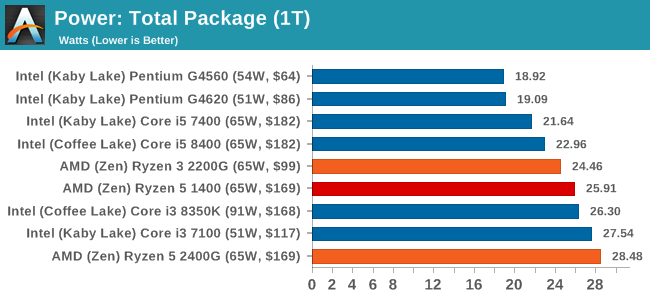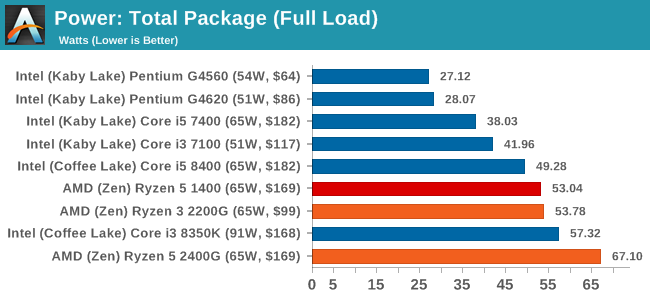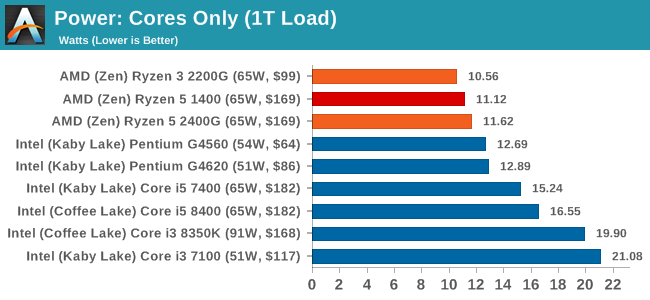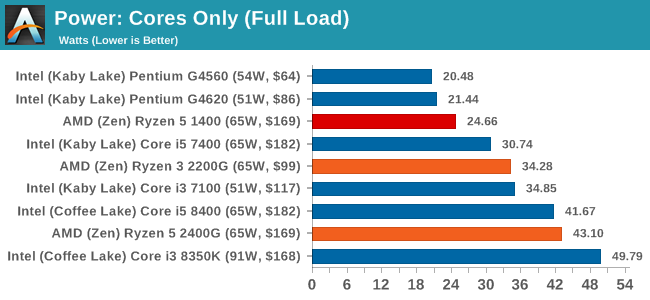Marrying Vega and Zen: The AMD Ryzen 5 2400G Review
by Ian Cutress on February 12, 2018 9:00 AM ESTPower Consumption
For our power consumption metrics, we use a Prime 95 blend on fixed threads to generate a strong load, and then poll the internal power registers that determine power state calculations to get the power consumption. Each processor is different in how it reports its power, which depends on the level of control the processor has: some of the more advanced CPUs, such as Ryzen, will provide per-core power numbers, while the latest Intel CPUs only give a figure for the CPUs as a whole but also include DRAM controller and uncore power consumption.
An interesting element to the power consumption on the Ryzen APUs, due to the unified power delivery subsystem in play feeding the CPU and the integrated graphics, is that the power registers only report half the power consumption when probed (e.g. when 14W, shows 7W). As of yet, we are unsure if this has a knock-on effect on how the processor adjusts its turbo modes in response to power consumption. Nonetheless, a simple scaling factor gives the following results.
Total Package: The Whole Processor
For this data, we take the values of the processor as a whole, which includes all the interconnect, memory controllers, PCIe root complexes, etc. The system is still only loading the CPU cores with minimal effect on the rest of the system, however depending on how the power is managed, some of the sub-systems still remain enabled.


At full load, the difference between the Ryzen 5 and the other Ryzen CPUs shows that the 2400G is using more of its upper margin, compared to the 1400 which is rated at the same power (note TDP is only determined at the base frequency), but the extra frequency of the 2400G means that there is extra power draw overall. Part of this is due to the Infinity Fabric, which we will see below. But what these tests also underline is that in a quad-core configuration, the Intel CPUs are still very power efficient.
Cores Only: Pure Work
For the processors that split out the data, we can look at the power consumption of the cores on their own, without any of the sub-systems, like uncore, mesh, or infinity fabric. This usually paints a different picture to the package power.


For the core only power, the Ryzen 5 2400G uses less power than the Core i3-8350K, despite the situation being reversed when considering the whole package. This means that Infinity Fabric takes a lot of power here, and the ring bus solution that Intel uses benefits from being simpler, and Intel can push more power to its individual cores.










177 Comments
View All Comments
AndrewJacksonZA - Monday, February 12, 2018 - link
Hi Ian. I'm still on page one but I'm so excited! Can a 4xx Polaris card be Crossfired with this APU?prtskg - Tuesday, February 13, 2018 - link
No crossfire supported by these apus, according to AMD. You can check it out on AMD's product page.dgingeri - Monday, February 12, 2018 - link
How many PCIe lanes are available on them? I didn't see that info anywhere in the article.iter - Monday, February 12, 2018 - link
Only 8dgingeri - Monday, February 12, 2018 - link
Well, not great, but it can still run a RAID controller off the CPU lanes and a single port of 10Gbe from the chipset, or run a dual port 10Gbe from the CPU and a lower end SATA HBA from PCIex4 from the chipset with software RAID. The 2200G could make a decent storage server with a decent B350 board. I could do more with 16 lanes, but 8 is still workable. It's far cheaper than running a Ryzen 1200 with a X370 board and a graphics card with the same amount of lanes available for IO use and a faster CPU.Geranium - Monday, February 12, 2018 - link
8 PCIe Gen3 for gpu+4 Gen3 for SSD+4 Gen3 for Chipset.andrewaggb - Monday, February 12, 2018 - link
What's with the gaming benchmarks... Is there a valid reason that no games were benchmarked at playable settings? I'm going to have to go to another site to find out if these can get 60ish fps on medium or low settings.... And I thought these were being pitched at esports... so some overwatch and dota numbers might have been appropriate.AndrewJacksonZA - Monday, February 12, 2018 - link
"and can post 1920x1080 gaming results above 49 FPS in titles such as Battlefield One, Overwatch, Rocket League, and Skyrim, having 2x to 3x higher framerates than Intel’s integrated graphics. This is a claim we can confirm in this review.""These games are a cross of mix of eSports and high-end titles, and to be honest, we have pushed the quality settings up higher than most people would expect for this level of integrated graphics: most benchmarks hit around 25-30 FPS average with the best IGP solutions, down to 1/3 this with the worst solutions. The best results show that integrated graphics are certainly capable with the right settings, but also shows that there is a long way between integrated graphics and a mid-range discrete graphics option."
I would love to see which settings BF1 would have 49FPS please. Is it with everything on low, medium?
Ian Cutress - Monday, February 12, 2018 - link
I've added some sentences to the IGP page while I'm on the road. We used our 1080 high/ultra CPU Gaming suite for two reasons.Manch - Monday, February 12, 2018 - link
Which are?